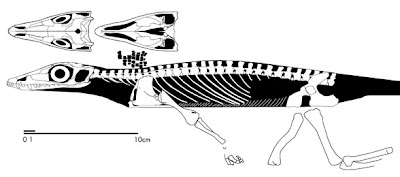A species of ancient predator with saw-like teeth, sleek bodies and a voracious appetite for meat survived a major extinction at a time when the distant relatives of mammals ruled the earth.
A detailed description of a fossil that scientists identify as a varanopid "pelycosaur" is published in the December issue of Naturwissenschaften – The Science of Nature. Professors Sean Modesto from Cape Breton University, and Robert Reisz from University of Toronto Mississauga provide evidence that a group of ancient, agile predators called varanopids survived for more than 35 million years, and co-existed with more advanced animals.
Modesto and the team performed a detailed examination of the partial skull and jaw of the youngest known primitive mammal-like animal, which they believe lived over 260 million years ago in the Permian Period. The fossils are from rocks forming the Pristerognathus Assemblage Zone of the Beaufort Group in South Africa.
"These animals were the most agile predators of their time, sleek-looking when compared to their contemporaries," says Reisz. "They seem to have survived a major change in the terrestrial fauna that occurred during the Middle Permian, a poorly understood extinction event in the history of life on land."
According to Modesto, who was once a student at U of T Mississauga, "these ancient animals really looked like modern goannas or monitor lizards, but are actually more closely related to mammals."
The fossil revealed teeth that are strongly flattened, curved towards the throat and with finely serrated cutting edges typical of hypercarnivores--animals with a diet that consists of more than 70 per cent meat.
Modesto and his colleagues concluded that these varanopids had a longer co-existence with animals that eventually evolved into mammals than previously believed. They suggest that the dental and skeletal design of varanopids, reminiscent of the Komodo dragon of today, may have contributed to their long survival and their success.
no time. But VERY interesting.

2 comments:
Neat. Will Late Permian varanopids be making an appearance in the XenoPermian? When is the next update for the XePe going to be, anyway? I am eagerly awaiting tales regarding the evolutionary history of neopareiasaurs and the pseudochelonids.
By the way, Will, since you seem to be the local expert on all things Permian, are there any books/papers you would reccomend to someone who wants to get a better feel for the fauna of the period?
Science and Technology Content for The Dragon's Tales
Hi,
My name is Ben Chasteen and I am the Science/Technology editor at Before It's News, a people-powered news site serving over 4 million people a month. We publish over 4,000 user-generated posts each day at BeforeItsNews.com.
I contacted months ago to see if you wanted to syndicate your RSS feed however, but didn't hear anything back. This time I am contacting you because I was wondering if you would be interested in receiving a short email of our top 5 Science/Technology stories each week? We have a lot of stories that the mainstream media don't cover. I think you'd find it a great source of unique information. If it's ok, please just email me back with a YES. You have my iron-clad promise that your email address will not be used for any other purpose or be added to any mailing lists.
I would also be your personal contact at Before It's News, should you ever have questions or need anything.
By the way, we also offer free WordPress blog hosting, and we can syndicate your RSS feed, if you're interested. Just let me know.
Thank you,
Ben Chasteen
Science/ Technology Editor
Before It's News
775 East Blithedale Ave. #362
Mill Valley, CA 94941
ben(AT)beforeitsnews(DOT)com
www.beforeitsnews.com
Post a Comment